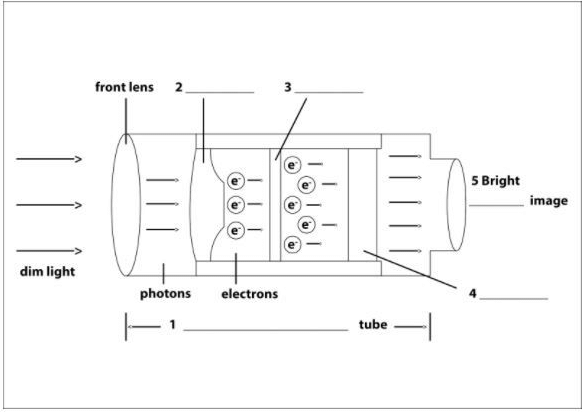Diagram Label Completion: Practice Test - 7 | Reading for Academic IELTS PDF Download
Directions: Answer the Diagram label completion questions from the passage as follows:
Night vision technology has transformed from old-fashioned bulky devices to compact sophisticated equipment that can intensify any light source up to 50,000 times. A device for night vision was first developed in the 1930s by the German military, and later by the Americans. Today, it has become an essential device in the kit of soldiers, permitting them to find out their targets in reduced visibility or complete darkness and move around in comparative safety as there are fewer chances of a surprise attack. ‘It improves their mobility, their survivability and their lethality’, says Lt. Col. Timothy Fuller.
So, what makes night vision possible? Light is an electromagnetic wave, and the entire range of light that exists is termed as the electromagnetic spectrum. The light visible to humans is only a part of this spectrum, while infrared light and ultraviolet light are invisible to naked eyes. The night vision devices work on two different technologies. The first is image enhancement using the tiny amount of light available which is collected and amplified to the extent that we can easily see the image. Thermal imaging, on the other hand, functions by capturing the higher areas of the infrared spectrum, which is radiated by objects as heat instead of light.
Even on dark nights, the stars and the moon emit near-infrared light. In a device that works on image enhancement technique, this faint light is captured to amplify it to a visible level. As the light consisting of photons enters the front lens of the image intensifier tube, it hits a photocathode which converts the photons into electrons. These electrons multiply as they pass through a thin microchannel plate. At the end of the tube, the electrons strike a phosphor screen which converts them back into photons and creates an image, usually green, on the screen. Since more photons are emerging than those which entered the tube, the image is much brighter than the original scene. Rich Urich, director of operations at Night Vision Equipment Company in Prescott Valley Arizona, says, ‘The reason it is green is because when you put the unit down, you want your eyes to remain dilated so you can see in dim light.’
Thermal imaging devices record the temperature difference between an object and its surroundings using a sensor called a microbolometer. An image of the object is created, which is then sent to the display where the user can see it.
However, it is not only in warfare that this technology finds use. Night vision equipment is used extensively by law enforcement departments to detect criminals in the dark. They are also used on borders to keep a check on illegal crossings. The technology is also used to find leaks and repair insulation in homes.
Q. Label the diagram below. Choose NO MORE THAN TWO WORDS from the passage for each answer.
Write your answers for 1–5 on your answer sheet.

Solution of 1:
"Image intensifier"
Paragraph 3 - As the light consisting of photons enters the front lens of the image intensifier tube, ...
Solution of 2:
"photocathode"
Paragraph 3 - ... it hits a photocathode which converts the photons into electrons.
Solution of 3:
"Microchannel plate"
Paragraph 3 - These electrons multiply as they pass through a thin microchannel plate.
Solution of 4:
"Phosphor screen"
Paragraph 3 - At the end of the tube, the electrons strike a phosphor screen which converts them back into photons ...
Solution of 5:
"Green"
Paragraph 3 - ... and creates an image, usually green, on the screen. Since more photons are emerging than those which entered the tube, the image is much brighter than the original scene.
|
27 videos|77 docs
|
FAQs on Diagram Label Completion: Practice Test - 7 - Reading for Academic IELTS
| 1. What is the IELTS exam and why is it important? |  |
| 2. Can I take the IELTS exam online? |  |
| 3. How is the IELTS exam scored? |  |
| 4. How can I prepare for the IELTS exam effectively? |  |
| 5. What is the validity period of the IELTS exam results? |  |
















